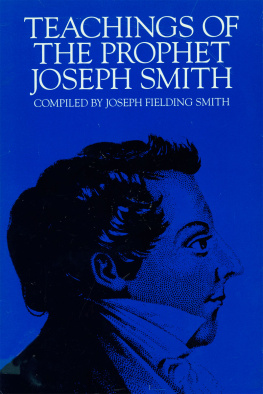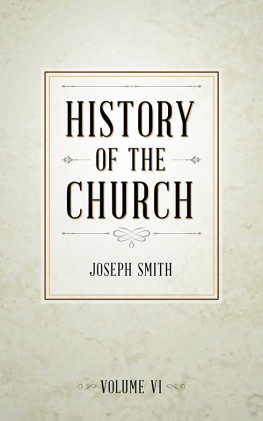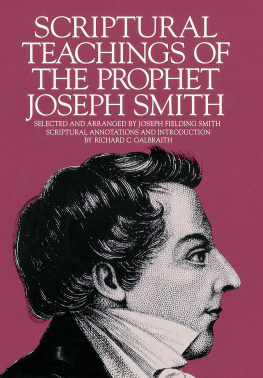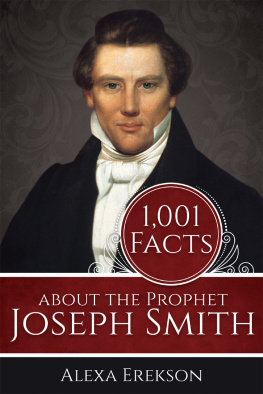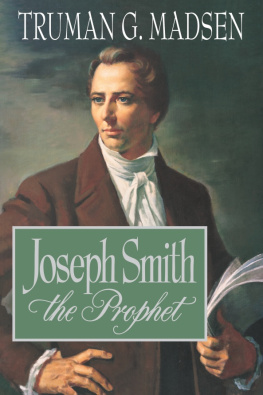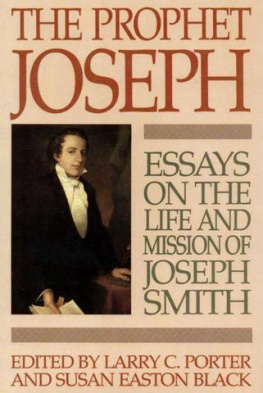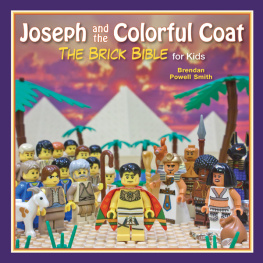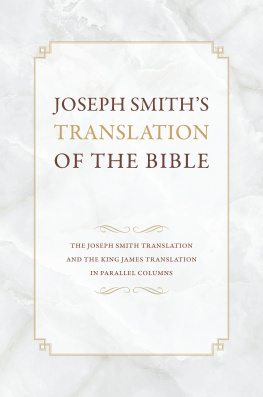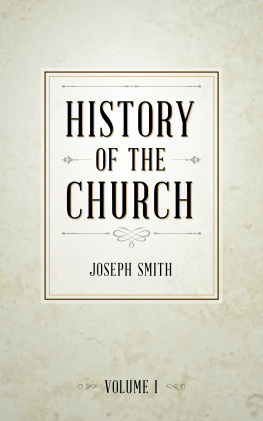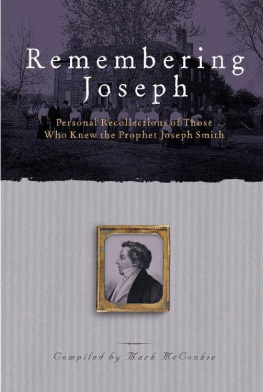Prophet and His Work: Essays from General Authorities on Joseph Smith and the Restoration
Various General Authorities
1996 Deseret Book Company. All rights reserved. No part of this book may be reproduced in any form or by any means without permission in writing from the publisher, Deseret Book Company, P.O. Box 30178, Salt Lake City, Utah 84130. This work is not an official publication of The Church of Jesus Christ of Latter-day Saints. The views expressed herein are the responsibility of the author and do not necessarily represent the position of the Church or of Deseret Book Company. Deseret Book is a registered trademark of Deseret Book Company.
INTRODUCTION
Some 2,000 years before the birth of Christ, Joseph of Egypt prophesied of Joseph Smith, Jr.an unschooled plowboy in nineteenth-century America who would become the prophet through which God would restore the gospel of Jesus Christ to the earth. "His name shall be called after me; and it shall be after the name of his father. And... the thing, which the Lord shall bring forth by his hand,... shall bring my people unto salvation" (2 Ne. 3:15).
In 1844, almost 2,000 years after the birth of Christ, John Taylor declared that "Joseph Smith... has done more, save Jesus only, for the salvation of men in this world, than any other man that ever lived in it" (D&C 135:3).
For literally thousands of years, prophets of God have testified with boldness about the life, mission, and divinely inspired work of Joseph Smith. It is in this tradition that we present this collection of essays.
The collection covers a wide range of topics concerning the Prophet, from personal testimonies of him, to details about his life and ministry, to his role in the larger gospel picture of the Apostasy and Restoration. Written by General Authorities of the Church, the essays center on personal conviction of Joseph Smith's calling as a prophet of God and the profound importance of his life and work.
We see Joseph from the time he was a small boy to the hour of his martyrdom. President James E. Faust and Elder Joseph B. Wirthlin show us in-depth the Prophet's associations with his family and friends, including his relationship with his brother Hyrum and his love for his parents, wife, and children. Of Hyrum, Joseph said, "I love him with that love that is stronger than death, for I never had occasion to rebuke him, nor he me."
Joseph Smith's leadership, service, and love for his fellowmen are legendary. In Thomas S. Monson's essay, "Teacher by Example," we read about the Prophet calling John Page to serve a mission in Canada. Brother Page responded, "'Why, Brother Joseph, I can't go on a mission to Canada. I don't even have a coat to wear.' The Prophet Joseph took his own coat from his back, handed it to John Page, and said, 'Here, John, wear this, and the Lord will bless you.'" In Neal A. Maxwell's essay, "Joseph, The Seer," we learn how Joseph risked his life for a young man by carrying him upon his shoulders through swamp and darkness as a mob pursued them. A letter to Jared Carter from the Prophet reads, "I love your soul, and the souls of the children of men, and pray and do all that I can for the salvation of all."
In addition to showing Joseph as a remarkable man, the authors forthrightly proclaim him as a prophet, seer, and revelator of God. Joseph's contributions as a prophet are also acclaimed by prominent scholars who are not members of the Church. For example, Elder Joe J. Christensen quotes Dr. Harold Bloom, a distinguished professor at Yale University: "I also do not find it possible to doubt that Joseph Smith was an authentic prophet. Where in all of American history can we find his match?"
Many essays included in this collection focus on the Apostasy and Restoration. Elder Dallin H. Oaks and Elder F. Enzio Busche write clearly about gospel truths that were lost or changed after the time of Christ, differences between our church and other Christian churches, and why the Restoration was necessary. Other essays discuss in detail the beautiful truths of the gospel that were restored. For example, in the essay entitled "Oh, How Lovely Was the Morning!" Elder Carlos E. Asay highlights ten eternal truths we learn from the First Vision. In "Our Message to the World," Elder Robert E. Wells places Joseph Smith as part of the Christ-focused message of Latter-day Saints to the world and states, "When one studies the doctrinal teachings revealed to Joseph Smith, that person, if he or she is sincere in the search for truth, will be led to Jesus Christ."
Varied in scope, The Prophet and His Work includes unusual works not often found in a collection about Joseph Smith. For example, Elder M. Russell Ballard, a descendant of Hyrum Smith, writes about the life of the Prophet's brother. And in the chapter "At the Heart of the Church," Elder Russell M. Nelson helps us prepare for attacks that may be made against the Prophet.
Ultimately, though, the thrust of these essays is the personal testimony each of our leaders offers of Joseph Smith. "I have never forgotten that moment in my life," says President Gordon B. Hinckley of one of the formative experiences in his testimony of Joseph. "I was an awkward, freckled-faced little boy in knee pants, more prone to laugh than to be serious. But on this occasion, I felt a great moving power. It was both emotional and spiritual,... its testimony has become my own testimony." Many of the authors have traveled to the sites of Joseph Smith's history, where the Father and the Son appeared to Joseph, where the plates were hidden up, where the first temple of this dispensation was built. They have been to Liberty, where Joseph suffered and was comforted by the Lord, and to Carthage, where Joseph and Hyrum were brutally killed. They have fasted, they have prayed, and they have searched their own souls and found the deeply personal conviction that Joseph Smith is a prophet of God. It is to this truth that each of them testify.
Adding to the testimonies of prophets and apostles for centuries, The Prophet and His Work offers vibrant new insights into the life and work of Joseph Smith.
As One Who
Loves the Prophet
President Gordon B. Hinckley
I have chosen to write not as a scholar, but simply as one who loves a most uncommon man who was known by the common name of Joseph Smith.
May I tell you of some of the reasons for that love? I grew up in a home where there was love for the Prophet. That home included a substantial library. When we were ever so small our mother read to us from two books. They were titled From Plough Boy to Prophet and Mother Stories from the Book of Mormon. They were written by William A. Morton, who knew how to put words together so that children could understand and enjoy them. We also read from a small volume, published in 1900, titled The Latter-day Prophet, History of Joseph Smith. It was written for young people by George Q. Cannon. It is, in fact, a synopsis of the monumental life of the Prophet. Our library also contained a little red-cover book, Joseph Smith's Teachings, compiled and published by Edwin F. Parry in 1912. It likewise contained Joseph Smith the Prophet, written by his mother, Lucy Mack Smith. On two small tables stood two statues, each about twenty-six to thirty inches high. One was a miniature of the Joseph Smith statue by Mahonri Young, which stands on Temple Square. The other was a statue of Abraham Lincoln. I grew up in an environment of appreciation for the Prophet.



